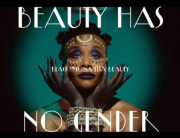Foundation is a liquid, cream, or powder makeup applied to the face and neck to create an even, uniform color to the complexion, cover flaws and, sometimes, to change the natural skin tone. Some foundations also function as a moisturizer, sunscreen, astringent or base layer for more complex cosmetics.
The use of cosmetics to enhance complexion reaches back into antiquity. “Face painting” is mentioned in the Old Testament (Ezekiel 23:40). Ancient Egyptians used foundation. In 200 B.C., ancient Greek women applied white lead powder and chalk to lighten their skin. It was considered fashionable for Greek women to have a pale complexion. Roman women also favoured a pale complexion. Wealthy Romans favoured white lead paste, which could lead to disfigurements and death. Men also wore makeup to lighten their skin tone; using white lead powder, chalk, and creams.The cream was made from animal fat, starch, and tin oxide.
Throughout the Middle Ages in Europe, it was considered fashionable for women to have pale skin, due to the association of tanned skin with outdoors work, and therefore the association of pale skin with affluence. In the 6th century, women would often bleed themselves to achieve a pale complexion.During the Italian Renaissance, many women applied water-soluble lead paint to their faces. Throughout the 17th century and the Elizabethan era, women wore ceruse, a lethal mixture of vinegar and white lead. They also applied egg whites to their faces to create a shiny complexion.Many men and women died from wearing lead-based make-up.
In the 18th century, Louis XV made it fashionable for men to wear lead-based makeup.Theatrical actors wore heavy white base.In the late 18th and early 19th centuries, Victorian women wore little or no makeup. Queen Victoria abhorred make-up and deemed that it was only appropriate for prostitutes and loose women to wear it. It was only acceptable for actors or actresses to wear make-up. In the late 19th century, women would apply a whitening mixture made out of zinc oxide, mercury, lead, nitrate of silver, and acids. Some women stayed out of the sun, ate chalk, and drank iodine to achieve whiteness.
Modern foundation can trace its roots to Carl Baudin of the Leipziger Stadt theatre in Germany. He is the inventor of greasepaint. He wanted to conceal the joint between his wig and forehead, so he developed a flesh-coloured paste made of zinc white, ochre, and vermillion in lard. This formulation was so popular with other actors that Baudin began producing it commercially, and, as such, gave birth to the first theatrical makeup.Although foundation make-up was widely available and used within the film industry, the use of cosmetics, in general, was still somewhat disreputable, and no one had tried to market foundation (although lipstick, blush and nail polish were popular for daily use) as an everyday item.
By 1940, it was estimated that one in three North American women owned and wore Pan-Cake.






Add Comment
You must be logged in to post a comment.